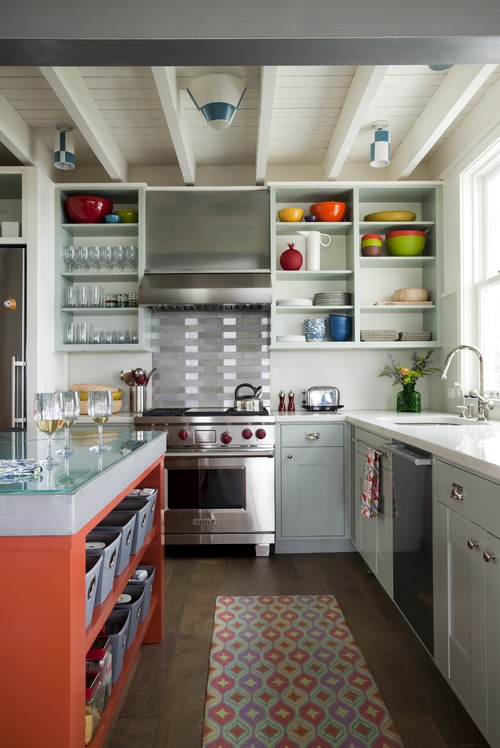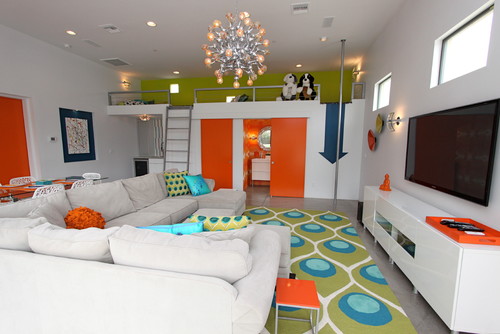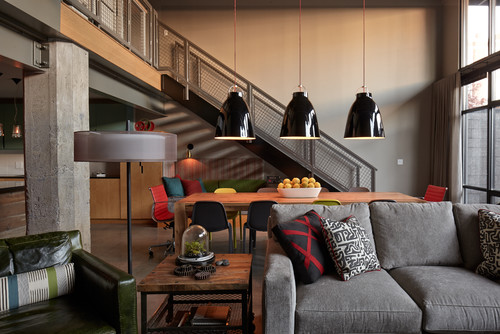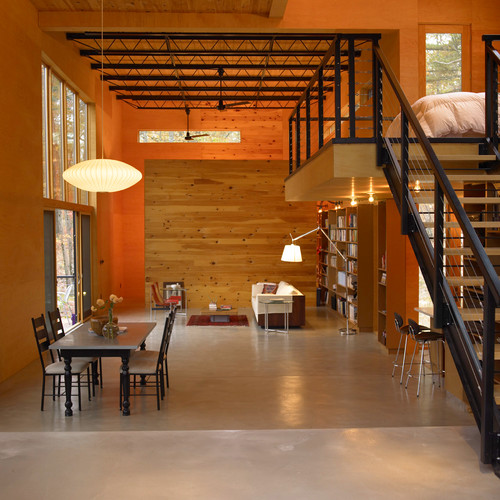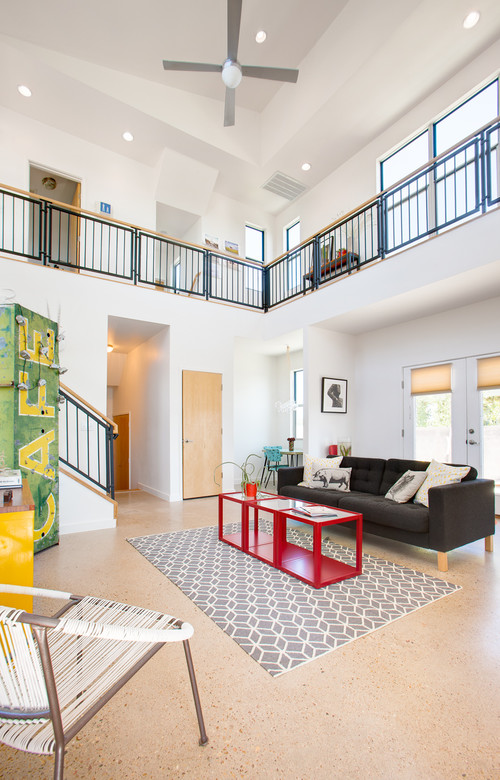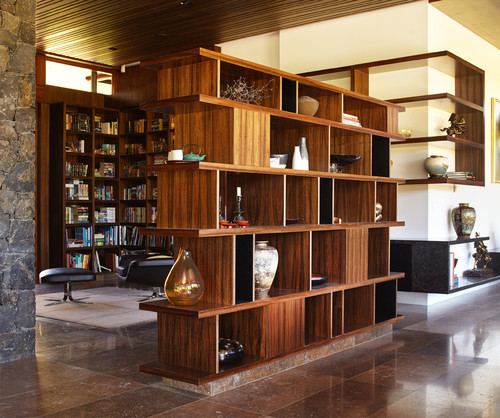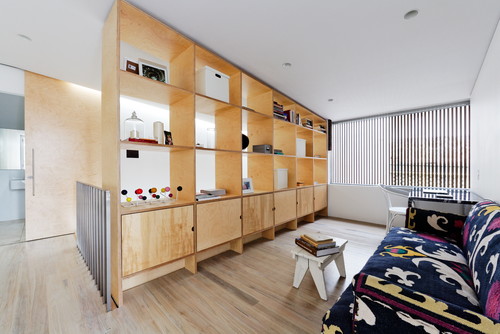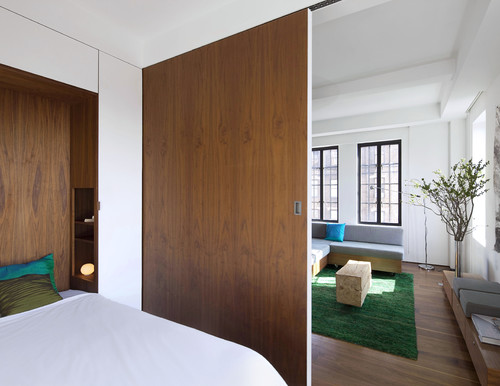Design Dilemma: A Pop of Orange
There’s no happier color in the rainbow than orange. Orange represents sun and warmth. It feels vivacious, expansive and bold. It was a favorite color in the 70s, when it moved into American homes along with avocado green. But unlike avocado green, orange maintained some staying power, and it still goes strong today, particularly in modern kitchens where it just feels right. Orange kitchen islands have become a favorite way to bring orange into the home, because it’s a way of doing it in a relatively small dose. It’s a powerful accent that can immediately pull a room together. And there’s something about orange that just seems to go well with food, too.
Don’t believe us? Come take a look:
Above, an orange accent wall and a kitchen island painted a pumpkin orange lends character and spunk to a kitchen that might otherwise come off as sterile considering the white cabinets and glass tile. The vibrant orange island adds personality without ever feeling like too much.
Similarly, a slightly more muted orange serves as a backsplash and accent underneath a waterfall countertop. This time, the orange with a bit more gray comes off as smooth and sophisticated when paired with gray taupe and dark brown cabinets. Now that’s a great way to do modern.
Again orange is paired with gray for a fresh feeling in a more traditional kitchen. What’s delightful is that the orange is nicely balanced by bright pops of color in dishes and the rug.
A smart way to ensure that orange looks like a plan and not an afterthought is to tie it in with smaller accents of the same color. Above, the orange island looks smashing when the back wall and niches painted in the same striking shade.
Finally, above, a beautiful modern kitchen uses orange not only on the kitchen island but on upper cabinets too. It never feels like too much. So the moral of the story is simply this: don’t be afraid to do orange. In an age of gray, taupe and beige, a bright, funky color can transform an otherwise boring space!
Design Dilemma: Tips for Decorating A Loft
Many of us covet the idea of living in a loft. All that open space. All that light. All that coolness.
And to be sure, loft living is cool. There are a myriad of benefits, including the ability to host fantastic parties. On the other hand, there is a down side: Lofts can be difficult to decorate if you don’t know what you’re doing. However, just keeping a few tips in mind can help you conquer the problem of the loft. Here’s what you should keep in mind:
- Consider color carefully.
The thing about the loft is that you take it in all at once. Without walls to separate the kitchen from the living room, dining room and bedroom, you get one overriding impression at one glance. This means that if color combinations have not been carefully thought out, you could have a mess on your hands. When combinations are well-thought out, they carry a huge impact. For example, in the loft below, complementary oranges blues and greens work well to create a cohesive space.
Below, another view. Notice how a chartreuse accent wall in the bedroom loft area works perfectly with the orange doors below. The bright oranges, turquoises and greens create a happy, youthful atmosphere that feels light and relaxed.
And here, a third view:
2. Light at different heights.
How you use light will help define space in one huge space. Use pendant lights hung low for a more intimate feel, for example over the dining table or a sitting area. Hang them higher in more “public” spaces like the entry hall and kitchen work zones. Below, a loft dining room rendered intimate by the use of three large pendant lamps.
And below here, a floor lamp near a couch and a pendant over a dining table help define space.
And below, a kitchen area is defined by pendant lamps.
3. Define rooms with area rugs.
There’s nothing like an area rug to neatly and quickly define a space. Be sure to use rugs that are large enough — small rugs look silly in large spaces. Make sure at least the front legs of all furniture can sit on the rug so that the rug acts as an anchor.
4. Use open-backed shelving.
One of the easiest ways to divide space is by using open-backed shelving placed perpendicular to the wall. The most important thing is to arrange open shelving so that it looks good from both sides.
5. Use flexible furnishings.
The great thing about lofts is they can be used in any way you want. So why not exploit all this space by utilizing pocket doors, convertible sofas, murphy beds and adjustable height tables for dining and lounging.
Follow these few tips and you’ll no longer feel overwhelmed by decorating your one huge space.
6 Things to Consider Before Buying a Safe
 Whether it’s a place to store important documents or a place to stow valuable jewelry, more and more of us are seeing the wisdom of having a safe at home.
Whether it’s a place to store important documents or a place to stow valuable jewelry, more and more of us are seeing the wisdom of having a safe at home.
The question is what type of safe to buy. There are actually different types of safes intended for different purposes, including protection against burglary, natural disasters or fire. Here’s what you need to know before investing in a home safe:
1. Not all safes offer the same level of security and quality.
Take into account a safe’s construction and fire-resistance rating.
- What is a safe made of? The strength of the material used will determine exactly how burgler-proof or fire proof a safe is. Steel is great but it’s expensive which is why many low-end safe manufacturers use thin steel walls. Thin steel does not offer much of an obstacle to penetration so choose 10 gauge as a minimum.
- How heavy is it? Heavier safes offer better protection, simply because the weight makes it much more difficult to run away with it.
- What is the fire rating? Safes are only fire resistant, not completely fireproof. Opt for at least a 1 hour fire rating or higher if your budget will allow for it.
2. The UL rating is important.
Accreditations by Underwriters Laboratories (UL) have become the industry standard. They are an independent, non-profit product-safety testing and certification organization. UL tests safes against fire, burglary, and gives them a rating based on how well they perform.
For details on safety ratings, see the UL’s official website: http://www.ul.com/
3. Fireproof is not burglar-proof or water-proof.
Unfortunately, a safe that is built for fire may not be built for flood. Assess what the most likely threat is in your area and purchase accordingly.
- If you’re worried about a burglary:
Burglar safes are designed to provide protection against forced-entry. They are classified based on the types of burglary tools that they are designed to resist and the total time that a burglar with these tools needs to penetrate the safe.
- If you’re worried about fire:
While there is no safe on the market today that is fully “fireproof”, there are a number of safes that are “fire resistant”, meaning that they resist heat and smoke over a specific period of time, usually between 30 to 150 minutes. If fire resistance is important to you, make sure you purchase a UL-rated safe with a certified fire rating. You should know that a “fireproof safe” is designed primarily to protect paper documents from heat or smoke, however, a standard fire resistant safe is fabricated with very thin metal which makes it fairly easy to break open. They are also lightweight, making them very easy to steal.
- If you’re worried about both burglary and fire:
BF stands for Burglary/Fire Safes. They are fire tested for 1 hour as well as tested against possible burglary attempts. Customers who are interested in some form of fire and burglary protection should choose this type of safe as they are designed and engineered to protect your valuables against BOTH burglary and fire.
- If you’re worried about water damage:
It’s important to note that in 95% of all fires, some water damage is likely to occur, even if it’s just from the water used to douse the fire. Therefore, you’ll want to always look for a safe that is water resistant and fire-resistant. Most safes that are theft and fire resistant also have some degree of water protection, meaning they have been tested by simulating the effects of a flood or cracked water line. Be sure to check the waterproof ratings if water is a concern for you.
4. Consider the item you want to protect.
- Wall Safes: While wall safes are often the first choice for a new safe buyer, they can’t support much weight and are not a good place to store high value items. Wall safes work best when storing paperwork or photographs but are limited in fire resistance and for thwarting burglars. The only fire protection they provide is the sheetrock in the wall. Additionally, if a burglar discovers a wall safe, he/she can often break into it within minutes.
- Floor Safes: Floor safes are great for gold, silver, coins, jewellery and other heavy valuable items because they are specifically engineered against burglary. Most people assume floor safes also offer excellent fire protection but often this is not the case. With the door being exposed and no fire board to dissipate the heat, heat from a fire can rapidly enter the safe. Unfortunately, nearly all floor safes are not made with a fire retardant door materials
- Weapons Safes: Do not forget that regular wall and floor safes are not designed for storing weapons or dangerous items. There are specifically designed weapon safes fitted with extra locks, pry-proof metal, and locking bolt technology to minimize risk of accidents.
- Media: Keep in mind, if you are planning to store media or data (hard drives, USB storage drives, SD cards, CDs, DVDs, etc.), you need a higher fire resistance rating than if you are only storing documents or jewels as these kind of items may be extremely heat sensitive! If you are storing media or data, consider buying a small UL-rated fire box for your data.
5. Be picky about the lock.
There are various kinds of locking mechanisms available on the market; mechanical dials, electronic locks, redundant locks and biometric scanners. Each type has its pros and cons. See the table below.
Lock Type
Dial Locks:
Pros:
❖ Can keep the same combo and it will not show wear
❖ Dials locks last a long time with the proper care
❖ The most inexpensive option and the most common
❖ Been around for over 150 years
Cons:
❖ You need to call a locksmith to change the combo
❖ It takes time to unlock and open
❖ Difficult for people with shaky hands or arthritis to open
❖ No lockdown mode
❖ Not convenient. It’s like an old rotary phone dial versus push button phone
Digital Locks:
Pros:
❖ Easy to change the combo
❖ Fast to enter the combo
❖ The owner picks the numbers so the combo should be easier to remember
❖ If an incorrect combo is entered 5 times it goes into lockdown mode and another attempt cannot be made for 5 minutes
❖ Perfect for the elderly or disabled
Cons:
❖ You have to change the batteries approximately once a year. (Combo will be remembered even if batteries go dead)
❖ Initial cost is more than a dial
❖ If it goes into lockdown mode because you forgot your combo, you have to wait 5 minutes until you can try again
❖ PIN code length up to 10 digits
Redundant Locks:
Pros:
❖ They consist of a mechanical and electronic lock in one, so if one fails the other will allow you access to the safe
❖ Rapid access, simplicity
Cons:
❖ If the lock fails and may require more than one drilled hole
Biometric Locks :
Pros:
❖ Fingerprint reading technology
❖ Incredible level of security
❖ Some models can store up to 50 fingerprints at a time
❖ Futuristic and modern appearance
❖ Redundant security (can optionally combine both electronic entry, as well as a fingerprint recognition)
❖ Entry enabling is even quicker than the digital locks
❖ Extremely easy to use
Cons:
❖ Vulnerable to weather conditions
6. Where to keep the safe.
One of the toughest decisions to make as a safe buyer is where to store it. If you do not own a burglar alarm system, then place your safe “out of sight, out of mind”.
- Store your safe in a place that is not easily accessible for intruders but not difficult to access for you.
- While a dark corner is always great for hiding a safe, the low visibility may cause you to enter the wrong password combination. Appropriate illumination to the inside of the safe as well as illuminating the lock area is helpful when inputting a combination or when storing valuables.
- Check if your floor is strong enough to handle the safe’s weight. The ideal for a safe is a concrete floor.
- Security should always be your number one priority. Many homeowners choose convenience over security and thus place their safe in the bedroom but the bedroom is often one of the first points of attack for a burglar to find valuable items.
- Safer areas to store a safe include an enclosed stairway with an access door, a utility room, a closet, or in the garage.



